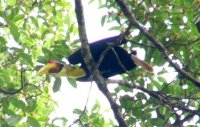FUJITA, Motoko
Research Theme
In environments where human activity exerts a strong influence, the presence or absence of many living organisms is connected to land use. There is a difference, for example, between the living organisms that inhabit rural environments, where second-growth forests and paddy fields are abundant, and those that inhabit urban environments, where isolated forests are scattered about surrounded by residential neighborhoods. In my research, I have studied the ways in which biota, and in particular avian species, are affected by changes brought on by these kinds of human-made environments, and what differences in ecological functions arise as a result, focusing my attention on nutrient transport (nitrogen and phosphorus).
Transport of Nutrients by Birds in Urban Landscapes
In my master’s and doctoral course research, I studied the role of bird feces in nutrient cycling of forest ecosystems. The population of forest bird species in the fragmented urban forests I surveyed was greater than the population in the mountain region. As a result, the amount of excreted nitrogen and phosphorus mediated by bird feces in the urban forests was more than double that of the mountain forests. In particular, crow roosts in the urban forests were found to be dropped 70 to 100 times the amount of nitrogen and phosphorus in the mountain forests.
The larger bird population in urban forests is not exclusively attributed to food resources available inside forests, since they also forage outside the urban forests, for example in residential neighborhoods. Measurements of stable isotope ratio and carbon, nitrogen and phosphorus amounts in bird feces suggested in fact that crows roosting in urban forests eat foods (e.g. garbage) found outside the urban forests they inhabited (Fujita & Koike, 2007).
In order to estimate the input of nutrients coming from outside the forests where the crows inhabited, the amount of nutrients attributed to internal cycle, foraged within the inhabited forests and excreted there, was deducted from total input of nutrients, defined as the total input from inside and outside the system. From this calculation, it was found that in crow roosts, allochthonous nutrient input accounted for 68 to 80 times the amount of nutrients attributable to internal cycle (Fujita & Koike, 2009).
In order to examine their fertilizing effect, a comparison was carried out between nutrients input via bird feces and those input into the forest ecosystem via various other pathways. While it is known that the other main input pathways of phosphorus are rain precipitation and weathered rocks, the comparison revealed that precipitated phosphorus from bird feces accounted for 3.6% in the urban fragmented forests and 265.4% in crow roosts there. Given that there tends to be a higher deficiency in phosphorus than in nitrogen, which is more abundant due to acid rain, the findings made clear the important role of bird feces as an input pathway for phosphorus.
Transport of Nutrients by Birds in Phosphorus-restricted Mountainous Tropical Rain Forests
Taking as subject of my study Mt. Kinabalu in Malaysia, a mountainous tropical rain forest where the level of phosphorus in the soil is extremely low, I am attempting to verify the hypothesis that in a phosphorus-restricted ecosystem, increases in bird-mediated phosphorus flow in internal circulation plays an important role in the input of phosphorus.
Diversity of Bird species in Large-scale Acacia Plantations in Southeast Asia
Tropical areas are a treasure trove of living organisms, tropical forests in Southeast Asia in particular being known for their high levels of biodiversity. In recent years, however, many natural forests have disappeared from the tropical areas of Southeast Asian countries, and in their place plantations of acacia, seringa and oil palm occupying vast tracts of land have proliferated at a startling rate. Pulpwood, rubber and palm oil, the products of these plantations, garner a higher commodity value, and for this reason these plantations have emerged as an important element of the industrial infrastructure in local communities. The demand for increasing transformation of tropical forests into plantations is expected to increase in the future due to the worldwide shift away from the use of fossil fuels, the major cause of global warming, and toward biomass-based energy.
This shift in the use of energy resources may provide solutions for a contemporary society that is heavily dependent on fossil fuel. On the other hand, however, the increasing transformation of tropical forests into large-scale plantations introduces negative consequences as well, since these plantations adversely affect living organisms in tropical forests and significantly reduce biodiversity there. In a society that is highly dependent on biomass, people are thought to be more intensely involved in the ecosystem than those in a society based on fossil energy. In particular, the destruction of natural forests to create large-scale plantations exerts an impact that is impossible to ignore, posing risks that threaten biodiversity. A decrease in biodiversity threatens the sustainable humanosphere, and thus in structuring a society that is highly dependent on biomass, we will have to face the issue of how to sustain biodiversity in large-scale plantations. The environment in these plantations may in fact epitomize the situation of contemporary society, where there is a demand to balance economic activity and environmental conservation. More so than the hot spots of biodiversity conservation, these plantations, which cause substantial damage to the ecosystem, may provide an important field of study for researchers seeking to strike a balance between industrial interests and conservation of biodiversity.
In my research, I have focused attention primarily on birds, studying the impact of changes in land use, such as the development of large-scale plantations, on the diversity of avian species. My aim is to demonstrate that decreases in the diversity of avian species can be mitigated via landscape management, which strives to bring about, at the landscape level, preservation of the original tropical forest within and around these plantations. By doing this, I would like to consider the possibilities of landscape management in large-scale plantations.
